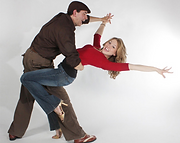
Revision Notes
For some of this year's classes, there will be brief revision notes available. So now you'll have no excuse for not remembering what you learned the previous week!
They are not a substitute for attending classes, though, as they may make little sense if you haven't seen and tried the steps yourself. However, armed with the names of the figures, you can then look them up on YouTube etc.
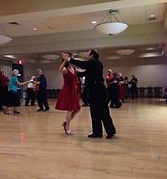
1.Direction of Movement and Alignments in the Ballroom
2.Rise and Fall
3.Footwork
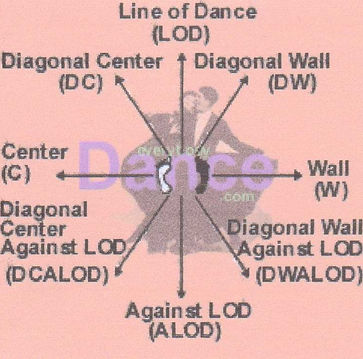
1. Direction of movement and Alignments in the Ballroom
1. Line of Dance.
The Line of Dance is the counterclockwise flow of traffic around the dance floor. It represents the general direction of movement overall, and is only pertinent to dances that travel continuously around the floor, such as Foxtrot, Waltz, Tango, and Quickstep. Not all movements must travel along the Line of Dance; Some will move across it, weave in and out, or even move against it for a short period of time. But the overall movement should continue to progress in the direction of the Line of Dance.
2. Points of Dance & Alignments.
These are measurements used to describe the position of the feet in relation to the room. These Alignments are used in the American Style Smooth and International Style Standard Ballroom dances.
The term "Llne of Dance" or "LOD" refers to both the specific alignment (see chart) as well as the general counter-clockwise flow of traffic around the dance floor. Why they're important? Navigation!
The terms used to describe alignment are:
-
Line of Dance (LOD,)
-
Center (C)
-
Wall (W)
-
Against Line of Dance (ALOD)
-
Diagonal Center (DC)
-
Diagonal Wall (DW)
-
Diagonal Center Against line of Dance (DCALOD)
-
Diagonal Wall Against Line of Dance (DWALOD)
modified by the terms:
-
Facing (F)
-
Backing (B), or
-
Pointing (P)
(The term "Pointing" is used to indicate a foot placement that is aligned differently from the direction that the body is facing; there are times when the foot should be placed pointing at the alignment you wish for your body to be facinq on a subsequent step. Accurate foot placement makes you are "sure footed" and prevents awkward-looking lines in the body.
2. Rise and Fall
The continuous elevation and lowering of the body through the feet, ankles and legs.
Rise and fall is a category of the ballroom dance technique that refers to rises and falls of the body of a dancer achieved through actions of knees and feet (ankles).
This technique is primarily recognized in International Standard and American Smooth dance categories. Rises and falls are important in Waltz, Foxtrot, Quickstep, and Viennese Waltz. Tango is described the "level" or "flat" dance, and its basic technique specifically eliminates rises/falls in the overall motion, with the exception of certain advanced figures.
3. Footwork
Footwork is defined as to what part of your foot comes in contact with the floor.
A clean footwork makes all the difference in dancing.
It is important to learn and practice the correct footwork as a beginner when executing the basic steps in order for this to become second nature later on as you progress to Improver and Intermediate level figures.
The correct Footwork is vital for the proper posture and movement of a dancer and also in artistic expression.
4. Contra Body Movement
A) Contra body movement (CBM) is a term used in ballroom dances, such as Waltz, Foxtrot, Tango, Quickstep.
CBM is used as a smooth transition from linear to rotational movement and is created by turning the right side of the body towards a left moving leg or turning the left side of the body towards a right moving leg. The body and the leg must move at the same time, and not one after the other. CBM occurs on forward or backward steps only (or diagonal steps which still feature forward or backward movement), and not on side steps.
B) Contra body movement position (CBMP) is a position rather than a movement. CBMP is the foot position achieved when the moving foot is placed on or across the line of the standing foot, in front of or behind it. CBMP is routinely used in steps taken in promenade position or outside partner step in order to maintain the relative body position of the couple.
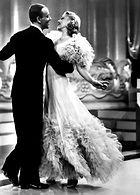
Social Foxtrot or Slow Rhythm
Beginners Lessons
We are starting with an introduction to the basic figures in Social Foxtrot. This is danced to 4/4 Rhythm (4 beats in a bar) and is ideal for a crowded dance floor.
The dance travels anticlockwise around the room with the leader facing the wall and the follower (in close hold) facing the centre of the room. Musical timing is divided into "Slows" and "Quicks"
i.e. SSQQ, SSQQ
The general pattern is that of a zig zag and in the basic, the men’s and women’s steps mirror each other throughout.
The leader takes 2 slow steps forwards, left foot then right foot, while the follower takes 2 slow steps backwards, right then left.
Both step sideways and close for 2 quick (half value) counts. This side-close is leftwards for the leader and rightwards for the follower.
Next the leader takes 2 slow steps backwards, left then right, while the follower takes 2 slow steps forwards, right then left. The side close is exactly the same as before.


Cha Cha Cha
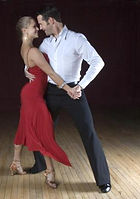
Rumba
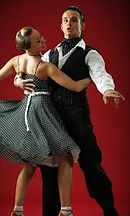
Triple Jive
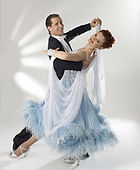
Waltz
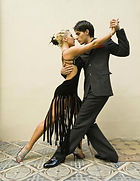
Tango

Slow Foxtrot
